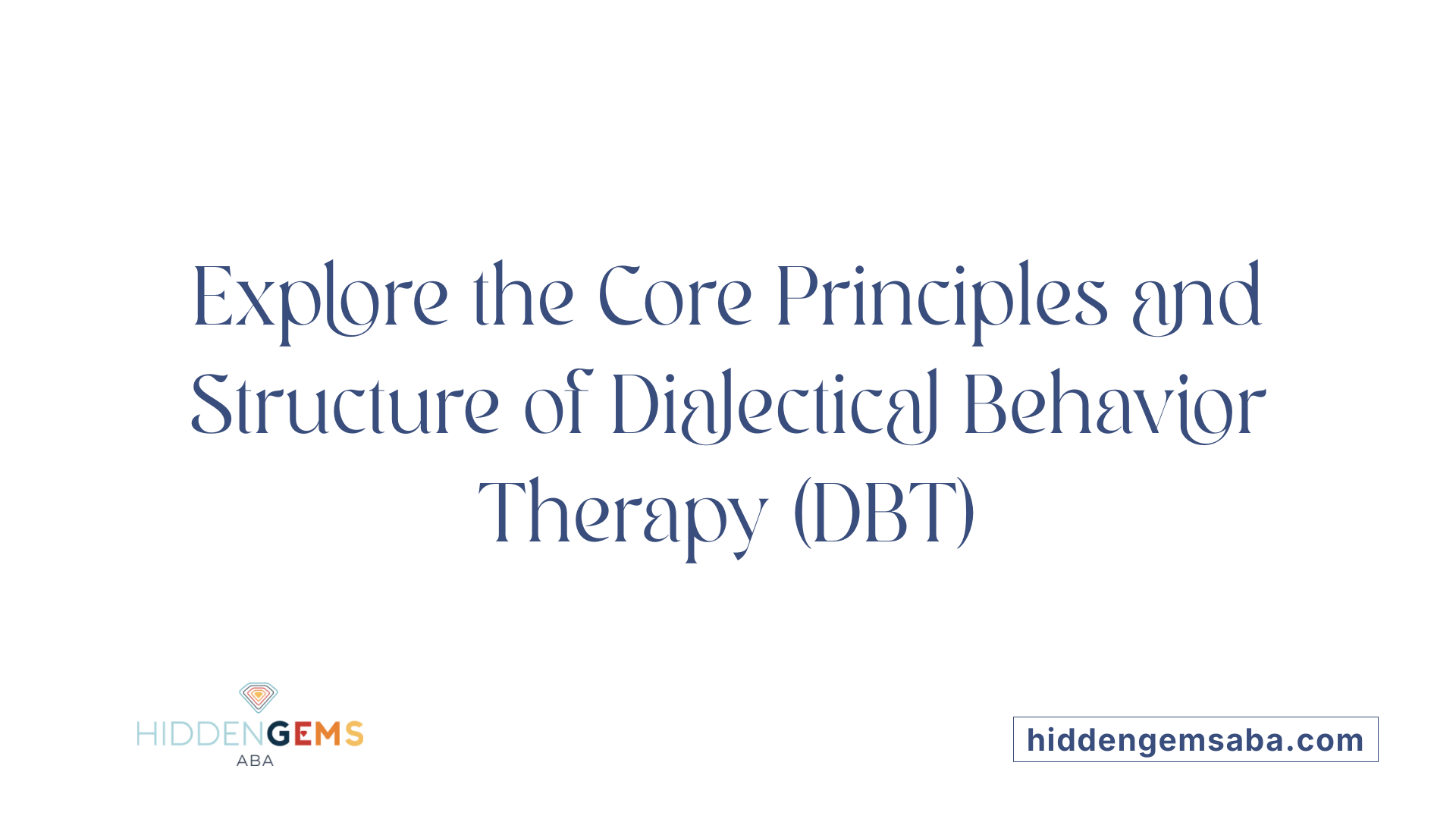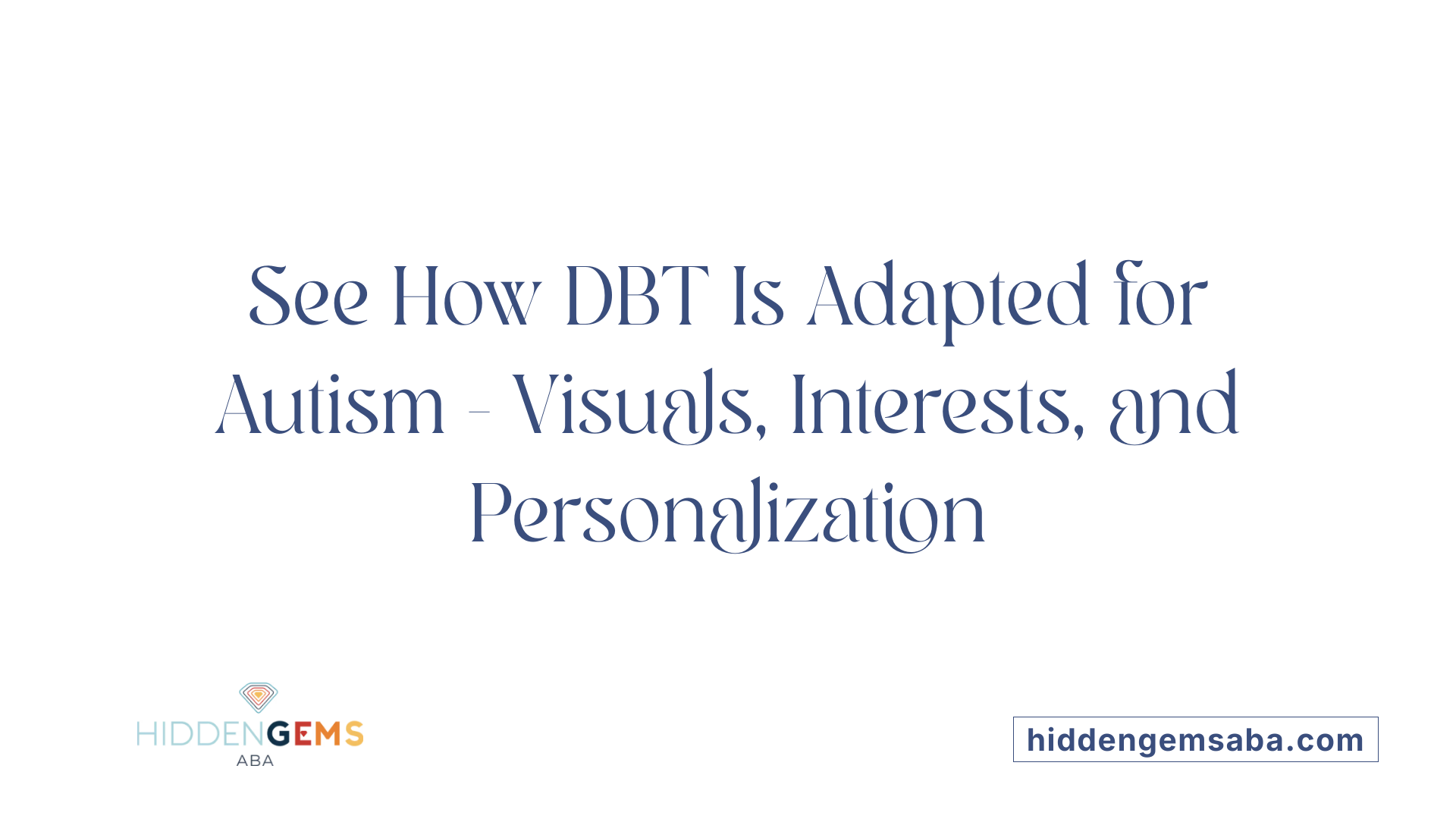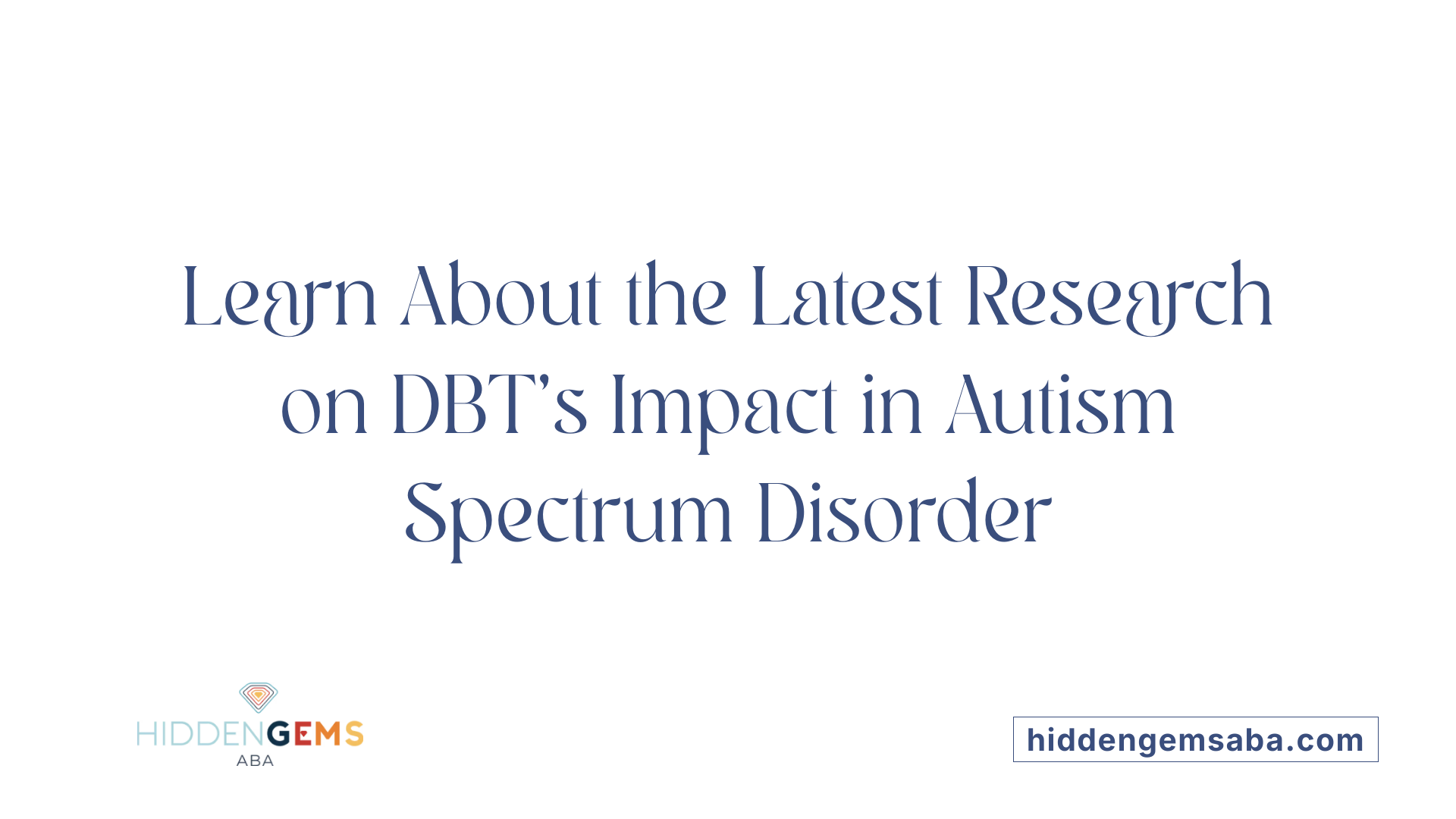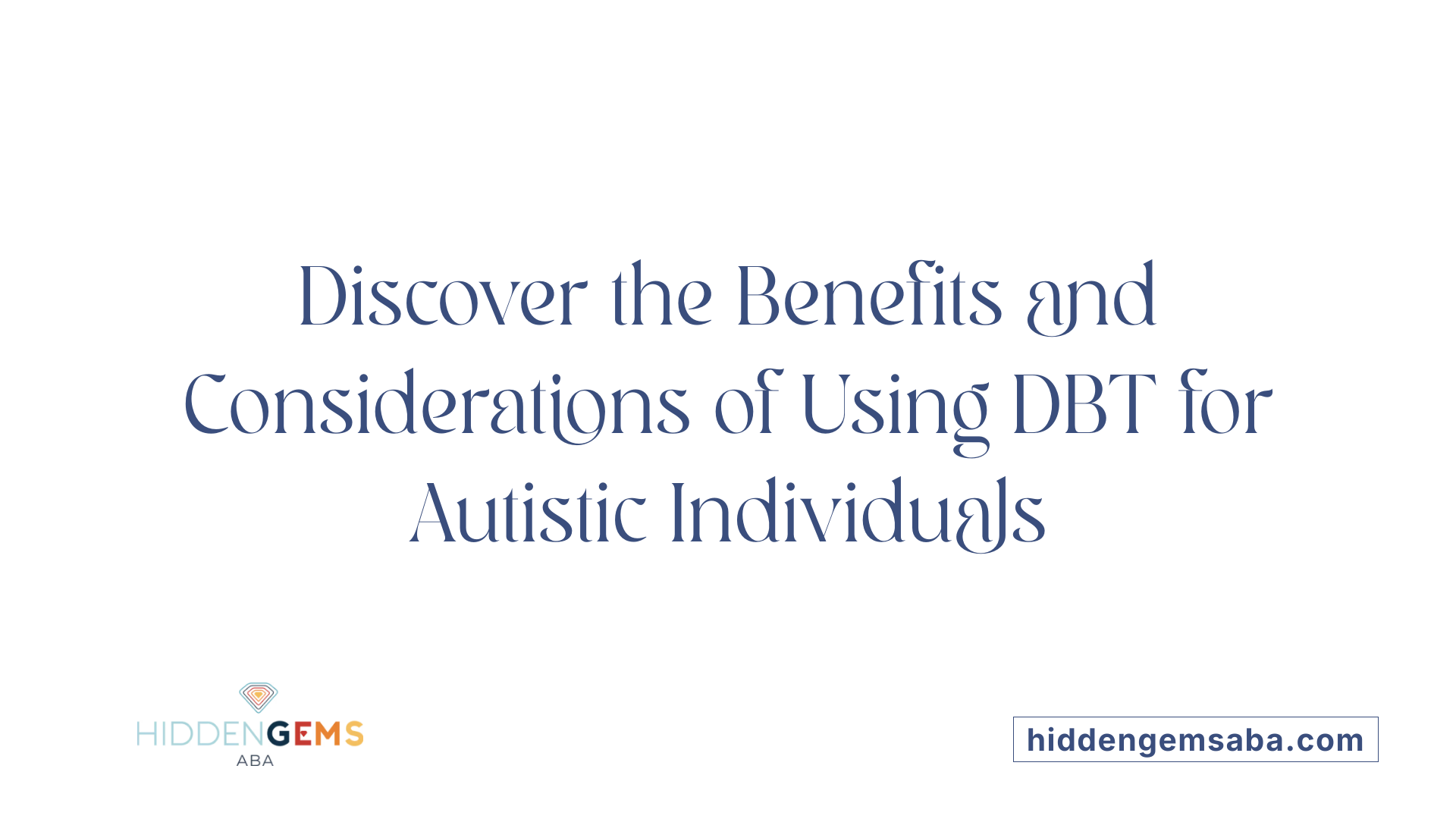Understanding DBT for Autistic Individuals
Dialectical Behavior Therapy (DBT) has gained recognition as a promising, evidence-based approach for addressing emotional dysregulation in various populations, including those on the autism spectrum. Originally developed in the 1970s by Marsha Linehan to treat borderline personality disorder (BPD), DBT integrates cognitive-behavioral strategies with acceptance-oriented techniques such as mindfulness and distress tolerance. Its core aim is to help individuals accept their thoughts, emotions, and behaviors while simultaneously working towards meaningful behavioral change. This structured therapy involves individual sessions, group skills training, phone coaching, and regular therapist consultations, typically over an extended period of six months to a year or more. Core skills include mindfulness, emotion regulation, distress tolerance, and interpersonal effectiveness, all designed to improve emotional stability and social functioning. While initially geared towards severe emotion dysregulation, recent research indicates that DBT can be effectively adapted for autistic individuals, offering a tailored approach to their unique needs.
Principles and Structure of DBT

What is Dialectical Behavior Therapy (DBT) and how does it work?
Dialectical Behavior Therapy (DBT) is a structured, evidence-based psychotherapy initially developed in the 1970s by psychologist Marsha Linehan. It was designed to help individuals struggling with intense emotions, emotional dysregulation, and self-destructive behaviors, particularly those with borderline personality disorder (BPD). Over time, clinicians recognized its potential benefits for other mental health conditions, including autism spectrum disorder (ASD).
DBT combines the principles of cognitive-behavioral therapy (CBT) with acceptance strategies drawn from Zen philosophy. Its main goal is to help clients accept their current emotional experiences while simultaneously working toward change. This balancing act is central to its practice and philosophy.
The therapy typically involves four main components:
- Individual therapy sessions
- Skills training groups
- Phone coaching
- Therapist consultation team
Participants usually engage in a structured program that lasts from six months to a year or more. Throughout treatment, they learn and practice four core modules of skills to better manage emotions and improve relationships.
Core modules of DBT (mindfulness, emotion regulation, distress tolerance, interpersonal effectiveness)
The four foundational modules of DBT provide clients with practical skills:
- Mindfulness: Teaching clients to focus on the present moment, increase awareness of their thoughts, feelings, and bodily sensations, and accept their experiences without judgment.
- Emotion Regulation: Helping individuals identify, understand, and modulate their emotional responses, reducing vulnerability to intense negative emotions.
- Distress Tolerance: Equipping clients with tools to handle crises and distressing situations without resorting to harmful behaviors, emphasizing acceptance and resilience.
- Interpersonal Effectiveness: Training clients to communicate their needs assertively, set boundaries, and maintain healthy relationships.
Therapeutic process and components
The therapy process involves a mixture of teaching, skills practice, and real-world application. Clients often use diaries or tracking sheets to monitor emotions and urges. The aim is to help individuals develop a life worth living by balancing acceptance of their current state with committed action toward positive change.
DBT's structure emphasizes a collaborative, respectful relationship between therapist and client. Therapists are receptive to client input, which can include personal interests, visual aids, and customized strategies. This flexibility enhances engagement for neurodiverse clients, including those with autism.
By integrating acceptance, mindfulness, and behavioral change techniques, DBT offers a comprehensive approach to managing intense emotions and improving overall functioning. Its adaptability to various populations illustrates its broad potential benefits.
Adaptations of DBT for Autistic Individuals

Can DBT be adapted for individuals on the autism spectrum?
Dialects of Behavior Therapy (DBT), originally designed for borderline personality disorder, can be effectively modified to meet the needs of autistic individuals. Recent studies and pilot programs have demonstrated that using visual supports, graphics, and gaming formats tailored to personal interests helps make DBT skills more accessible and meaningful.
Visual aids, such as illustrations and simplified teaching materials, are particularly useful in accommodating sensory sensitivities and social anxiety common among autistic clients. Incorporating graphics and interactive gaming elements aligns with many autistic individuals’ preferred learning styles, fostering engagement and reinforcing skill development.
In addition to visual adaptations, enhancements like sensory accommodations and leveraging special interests are integrated to improve participation. For example, customizing exercises to include preferred topics or activities can motivate clients and improve adherence.
Therapists’ openness to modifications and encouraging client-initiated contributions are considered essential. Collaborative approaches foster validation, build trust, and support the individual’s autonomy in therapy.
The core modules of DBT—mindfulness, emotion regulation, distress tolerance, and interpersonal effectiveness—are also tailored for autism by simplifying instructions and providing clear, predictable routines. These adaptations support emotional self-regulation, help manage impulsivity, and improve social skills.
Overall, adapting DBT for autism involves more than just material changes; it emphasizes a neuroaffirmative perspective that respects individual differences and promotes acceptance.
Research continues to expand on how best to implement these modifications in daily practice, exploring formats like self-monitoring tools, interactive activities, and incorporating clients’ personal interests to enhance the therapy's relevance and effectiveness.
Research Evidence of DBT’s Effectiveness in Autism
 Recent empirical studies have increasingly explored the benefits of Dialectical Behavior Therapy (DBT) tailored for autistic individuals. These investigations focus on its capacity to reduce emotional dysregulation, suicidal ideation, and harmful behaviors.
Recent empirical studies have increasingly explored the benefits of Dialectical Behavior Therapy (DBT) tailored for autistic individuals. These investigations focus on its capacity to reduce emotional dysregulation, suicidal ideation, and harmful behaviors.
A notable randomized controlled trial conducted in 2024 with 123 autistic adults demonstrated that those receiving adapted DBT showed significant decreases in suicidal thoughts, behaviors, and depression compared to those undergoing usual treatment. Similar smaller-scale pilot studies report high acceptability and positive user experiences, with participants often citing improvements in managing intense emotions and social difficulties.
One of the core adaptations involves the use of visual supports, graphics, and gaming formats. These modifications help address sensory sensitivities and communication challenges. For example, visuals and hands-on activities make emotion regulation skills more accessible, fostering better engagement and understanding.
Participants consistently indicate that such sensory and visual adaptations facilitate emotional awareness. They gain better recognition and expression of both positive and conflicting feelings, reducing alexithymia—a common challenge in autism—and promoting emotional clarity.
Follow-up studies suggest that the benefits of adapted DBT are not only immediate but also long-lasting. Participants often continue to report improved emotional control and reduced harmful behaviors months after completing therapy. This underscores the potential of DBT to provide sustainable improvements in emotional well-being.
In summary, recent research confirms that tailored DBT effectively enhances emotional regulation in autistic adults. Its incorporation of visual, sensory, and personal-interest-based strategies plays a critical role in its success. While promising, ongoing studies are essential to refine these interventions and better understand long-term outcomes.
Benefits and Limitations of DBT for Autism

What are the benefits of using DBT for children and adults with autism?
Dialectical Behavior Therapy (DBT) offers several advantages for individuals on the autism spectrum, both children and adults. It is particularly effective in helping manage emotional dysregulation, a core challenge in autism. Many autistic individuals experience intense emotions, sensory overload, and impulsivity, which can lead to self-injury, withdrawal, or aggressive behaviors.
Modified DBT integrates visual aids, graphics, gaming formats, and personal interests to make skills more engaging and meaningful. These adaptations serve to improve motivation, understanding, and retention of coping strategies.
DBT’s structured approach targets emotional regulation, social skills, and self-acceptance, fostering a sense of self-awareness and empowerment. It can also significantly lower risk factors like suicidal thoughts, self-harming behaviors, and severe anxiety.
Research indicates that even short-term DBT intervention—such as 18 weeks—can produce measurable reductions in emotional challenges. For example, studies have shown improvements in self-regulation, social functioning, and overall well-being.
How does DBT impact emotional regulation and social skills?
A crucial goal of DBT is to improve emotional resilience. Autistic individuals often struggle with understanding and expressing feelings, especially in social contexts. Through skill modules like mindfulness and interpersonal effectiveness, clients learn to recognize their emotions, tolerate distress, and navigate social interactions more successfully.
Programs customized for autism may include visual diagrams, game-based activities, and emphasis on clients’ special interests, making learning more accessible and enjoyable. Enhanced emotional regulation helps reduce impulsive behaviors and social misunderstandings, leading to improved relationships and daily functioning.
How does acceptance and self-awareness improve living with autism?
DBT's focus on acceptance promotes self-compassion, helping autistic individuals accept their traits rather than view them as flaws. This approach can lessen stigma, increase self-esteem, and support mental health. Clients develop a more integrated, authentic sense of self, which is crucial for building confidence and resilience.
Practicing mindfulness and self-acceptance, especially tailored with visual supports or interests, can help clients better manage sensory overload and social anxiety. This supports their ability to participate more fully in social and daily activities.
What are the limitations and individual differences?
Despite promising results, DBT is not universally effective for all autistic individuals. Some may not respond as well due to the severity of their symptoms, co-occurring conditions, or personal preferences. The therapy requires motivation, effort, and the ability to engage with structured activities, which vary among individuals.
Additionally, more empirical research is needed. Many studies are preliminary, with small samples and short follow-ups. Larger and longer-term studies are essential to confirm and refine adaptations of DBT for autism.
Why is further research needed?
While current evidence supports the feasibility and potential benefits of adapted DBT, further investigation is necessary to understand its long-term effects, optimal delivery formats, and specific components that work best. Expanding studies on daily self-monitoring tools, personalized visual and gaming strategies, and the integration of personal interests will help tailor interventions more effectively.
Overall, DBT shows promise as part of a comprehensive support plan for autistic individuals, but continued research is vital to optimize its use and ensure broad accessibility and efficacy.
Harnessing the Potential of DBT in Autism
Overall, research and clinical practice indicate that DBT, when carefully adapted to meet the sensory, communication, and emotional needs of autistic individuals, holds significant promise for improving their emotion regulation, mental health, and social functioning. The collaborative, validation-focused approach fosters self-acceptance and empowerment, crucial for fostering resilience in this population. While further large-scale studies are necessary to confirm its efficacy across diverse groups, early evidence points to the importance of continued development and refinement of neuroaffirmative DBT protocols. Integrating visual supports, interests, and sensory considerations can make DBT a vital component in the comprehensive mental health care of autistic individuals, promoting a life worth living.
References
- Leveling Up Dialectical Behavior Therapy for Autistic Individuals ...
- Dialectical Behavior Therapy for Autistic People - Psychology Today
- Dialectical Behavior Therapy in Autism - PubMed
- The effect of dialectical behaviour therapy in autism spectrum ...
- How DBT Can Help Empower Children on the Autism Spectrum
- Therapy for People with High Functioning Autism
- Feasibility, Acceptability and Preliminary Efficacy of Dialectical ...
- Can DBT be useful for managing Autism?
- Dialectical Behavioral Therapy & Autism: An Empowering Set of Skills





